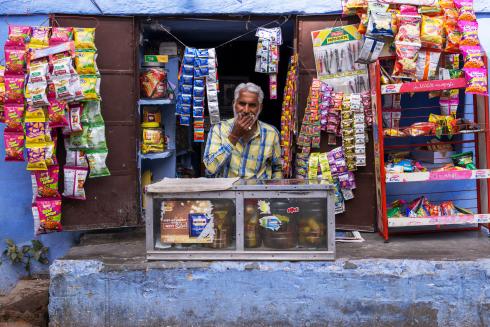
Innovations in microcredit design can improve business growth and borrower wellbeing.

Microcredit providers and funders can improve the model by providing the right financial products to the right people. Design changes that go beyond the traditional one-size-fits-all model by improving targeting, flexibility, and privacy can lead to bigger gains in borrowers’ business growth and earnings, especially for experienced and women entrepreneurs.
Microcredit providers should invest in finding ways to scale up effective product innovations. Recent research shows that improved targeting and flexible designs can increase effectiveness while keeping default rates in check. Donors and investors can support testing of more credit innovations, and work with financial service providers to develop pathways to scale.
Microcredit was once hailed as a silver bullet for poverty, but randomized evaluations showed only modest impacts on income or business growth overall. The idea behind microcredit is simple: Every business needs capital, yet many in low-income communities can’t access financing. With an estimated US$5.7 trillion financing gap for small businesses worldwide, policymakers and financial service providers hoped to unlock growth by giving small loans to entrepreneurs excluded from traditional banking. But borrowers under original microcredit models weren’t consistently earning more, growing their businesses, or improving their lives. Research suggested a different approach: more tailoring can help.
Finding and giving larger loans to high-potential entrepreneurs can boost borrowers’ business profits and household income. Microcredit delivers strong results for experienced business owners. Finding those people effectively and efficiently can boost the overall impacts of credit programs. There are several promising ways to find them: Community insights, mobile phone data, and machine learning with psychology data can identify who is most likely to grow their business with credit. Providing high-potential entrepreneurs with different support, like loans that are several times larger than the usual microcredit, or asset-based microfinance, led to growth, too.
Small design tweaks like grace periods or flexible repayment can improve microcredit’s effectiveness. In India, offering a two-month grace period raised recipients’ business profits by 41 percent and household income by 20 percent, though it also increased defaults slightly. Newer studies in South Asia and Latin America show that flexible payment contracts can raise small business profits or household income without necessarily causing defaults to go up, especially by helping experienced borrowers invest when cash flow is uncertain.
Giving women access to bank accounts or digital payments can help them keep control of their loans and invest more in their own businesses. Traditional microcredit hasn’t consistently increased women’s empowerment, even though most loans target women. Private bank accounts and payment systems help reduce family pressure to share money, and support women’s entrepreneurial success.
Microcredit remains one of the most accessible financial products for low-income entrepreneurs. For some low-income families, access to savings or insurance may be more helpful than credit. Still, many can benefit from evidence-informed, improved microcredit.
Cost and design considerations
Lenders often face a tradeoff between tailoring loan products to improve outcomes and maintaining scalability and cost-efficiency of credit programs. Research suggests some ways to make microcredit programs more effective, without necessarily increasing default rates. But making these innovations scalable and cost-efficient for lenders will require more testing, investment, and integration into lending practices.
Beware of market saturation and effects of loans on the whole community. Even those who do not borrow may be affected by credit. In areas where many people start similar businesses using loans, competition can lower profits for some firms. Yet credit can also improve business quality and lower prices, benefiting community members who do not borrow. Microcredit programs should take local contexts into consideration when deciding how much credit to extend to local clients, and measure impacts on borrowers and nonborrowers whenever possible.
There is a tradeoff between focusing on higher returns and financial inclusion. When people use loans to smooth income or manage shocks, microcredit may not grow businesses, but can still help families meet basic needs in situations with limited safety nets. Governments and blended finance can help more people access microcredit for household resilience.
While both grants and loans can help microentrepreneurs grow and increase their incomes, well-designed loans are often more cost-effective over time. Grants, like giving cash or in-kind equipment or inventory, lead to large short-term gains for microentrepreneurs. Loan programs often match these impacts at a lower cost, making them cost-effective even when they are subsidized, especially when evaluations take into account how loan capital is reused. In Egypt, for example, microcredit and grants both led to similar income increases, but microcredit cost three to five times less than cash grants.
Flexible loan designs boost cost-effectiveness by enabling riskier, high-return investments, and better targeting—whether for grants or credit—can ensure resources go to those most likely to benefit. It’s important to note that this comparison is focused on encouraging income growth among microentrepreneurs; grants used for social protection, like cash transfers or programs to help the extreme poor, serve a different purpose and are often effective in improving household welfare.
Making these innovations scalable and cost-efficient for lenders will require more testing, investment, and integration into lending practices.
Implementing partners

Implementers bring deep local knowledge, technical expertise, and a commitment to evaluation and learning as they bring these programs to life. Many microfinance institutions offer innovative microcredit approaches, including the following (listed in alphabetical order); this list is not exhaustive.
- BRAC (South Asia and Africa)
- Compartamos Banco (Latin America)
- Grameen (Worldwide)
- FINCA (Africa)
- Fondo Esperanza (Chile)
- Opportunity International (Worldwide)
- Sonata (India)
- VFS Capital (India)
Over the past decades, social enterprises have played a central role in pioneering and scaling the microcredit model around the world. Grameen, founded by Nobel Peace Prize laureate Muhammad Yunus, introduced the modern microcredit model in the 1970s. With a blend of a social mission (expansion of financial access) and commercial strategies, organizations such as Grameen, BRAC, and FINCA have developed large-scale lending programs, offering microcredit alongside financial literacy training, savings, livelihoods support, and other programs to millions who were previously underserved.
The role of low- and middle-income country governments
Governments in low- and middle-income countries play a key role in shaping microfinance by creating enabling environments through regulation and funding, subsidizing outreach to underserved areas, and sometimes creating state-run or regulated microfinance institutions. Effective coordination between public and private actors also helps steer the industry toward inclusion, consumer protection, and integration with social protection systems.
Discover more from J-PAL
One Size Doesn’t Fit All: Tailored Microcredit Approaches Can Help Borrowers
Encouraging micro and small enterprises to formalize
Teaching business skills to support microentrepreneurs
Discover more from other sources
Making Microfinance More Effective
Harvard Business Review
Microfinance: Issue 3
VoxDevLit
Photos:
(1) A young African businesswoman in a local market. Credit: Shutterstock.com
(2) Credit: Nokuro, Shutterstock.com








